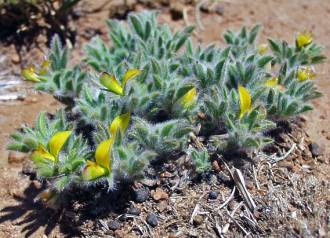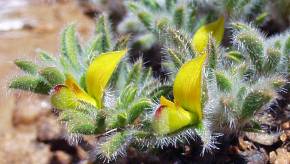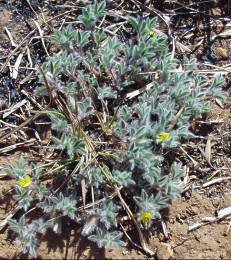Lotononis calycina
Lotononis calycina (E.Mey.) Benth.
Family: Fabaceae
Common names: hairy Lotononis, namele (Sotho )
Introduction
A small flat-growing yellow-flowered leguminous herb graces the dreary Highveld landscape in early spring. This delicate silvery plant highlights the importance of appreciating the Highveld in all seasons.

Description
Description
Lotononis calycina is a prostrate (flat-growing) perennial herb growing at altitudes of 458-1730 m, often forming mats. Plants are short-lived and flower from the first year of growth and resprout every year from an undivided tap root. Leaves are trifoliolate (having 3 leaflets) with the leaflets elliptic-obovate, apiculate (having a short, sharply pointed tip), hairless above and hairy below. Flowers appear in groups of 1-3 and are leaf-opposed; the standard (the broad, upper ± erect petal) is bright yellow, somewhat shorter or equal in length to the keel (the 2 front petals fused into a boat-shaped structure), hairy on the outside; the wings (the 2 side petals, one on each side of the keel) are characteristically much shorter than the keel; the keel usually has a blunt reddish-purple tip and is hairy. Flowering time ranges from August-December. Pods are narrow, oblong-obovate and densely hairy.

Conservation Status
Status
Lotononis calycina currently has no IUCN Threat Status since it is one of the most common species in the genus. The species occurs over a rather large geographical area and is not confined to specific substrates, although clearly having a high affinity for dolomite. Agricultural and urban development may endanger its distribution in Gauteng; however, the species is widespread in many of the nature reserves within the Province.
A close relative of this species, L. adpressa subsp. leptantha is classified according to IUCN standards as being Data Deficient and therefore possibly in need of official protection. The two superficially similar species can easily be distinguished by checking the upper surface of leaflets; those of L. adpressa subsp. leptantha are densely hairy, whilst those of L. calycina are hairless.
Distribution and habitat
Distribution description
Lotononis calycina occurs in most of the northern and eastern parts of southern Africa, and its distribution range extends to Angola, Namibia, Zimbabwe and Lesotho. In South Africa, the species is especially widespread in the eastern half of the country and occurs in the provinces of Limpopo, North West, Gauteng, Mpumalanga, Free State, KwaZulu-Natal, Northern Cape, and Eastern Cape.
It grows in undisturbed grassland but has been recorded to colonise disturbed areas, such as roadsides, to a minor extent. This species is frost-tolerant and adapted to summer rainfall.
Derivation of name and historical aspects
History
By most standards, Lotononis is a large genus with about 150 species of which 144 occur in southern Africa. The genus is particularly common in temperate southern Africa, with a few species present in northern Mediterranean Africa, eastern and central Africa, and Pakistan. The species richness, however, decreases drastically from south to north.
Lotononis calycina was first described in 1836 by Ernst H.F. Meyer from material collected by Drège in the Eastern Cape Province of South Africa.
Ecology
Ecology
As with most of our indigenous wild flowers, we have no knowledge of this species' pollinator, mechanism of seed dispersal or other plant-animal interactions. Since the flowers are rather small, one might guess that the likely pollinators are small, solitary bees or dipterans. This plant can also be classified as one of the so-called pre-rain flowers of the Highveld. Many plants of the Highveld Grassland accumulate and store water in underground storage organs such as roots and bulbs which allows them to resprout in early spring regardless of rainfall. It is hypothesized that this gives them a competitive advantage with regards to pollination over the many and much taller grass species in the biome.
Uses
Use
Ethnobotanically, it has been recorded that the Southern Sotho use L. calycina in a mixture of other Lotononis species (L. decumbens subsp. decumbens, L. decumbens subsp. rehmannii and L. mucronata) to prepare a bronchitis remedy for children.
No other traditional economic, medicinal or other uses are known. The flowers are exceptionally small, yet striking in appearance and it should be interesting to know which insects visit them. Because of its attractive leaves, this plant should not be overlooked as a potential horticultural candidate, especially for ground covering purposes and in rockeries.

Growing Lotononis calycina
Grow
As with many of our indigenous Highveld species, no information exists as to the growing conditions and requirements for L. calycina. One may deduce from the phenology (the study of the pattern of events in nature) the periods when and for how long the plants flower, fruit, produce seeds, etc.) when optimal planting time should be, and try to simulate, as far as possible, conditions in the wild. Often the seeds are heavily parasitised by insects and care should therefore be taken when harvesting them from nature to select only viable ones. Seeds should be sown late in winter or early spring and watered regularly until they germinate. Once planted, L. calycina should not be removed, because damage to the roots could cause the plant to die.
Internet resources:
References
- LETTY, C. 1962. Wild flowers of the Transvaal. Wild flowers of the Transvaal Book Fund, Pretoria.
- POLHILL, R.M. 2003. Lotononis. Flora Zambesiaca 3 (7): 240-241.
- POOLEY, E. 1998. A field guide to the wild flowers of KwaZulu-Natal and the eastern region. Natal Flora Publications Trust, Durban.
- VAN WYK, B.-E. 1991. A synopsis of the genus Lotononis (Fabaceae: Crotalarieae). Contributions from the Bolus Herbarium 14, University of Cape Town.
- WATT, J.M. & BREYER-BRANDWIJK, M.G. 1962. The medicinal and poisonous plants of southern and eastern Africa, edn 2. Livingstone, London.
Credits
Alicia Grobler
National Herbarium, Pretoria
November 2010
Plant Attributes:
Plant Type: Perennial
SA Distribution: Eastern Cape, Free State, Gauteng, Limpopo, Mpumalanga, North West, Northern Cape
Soil type:
Flowering season: Spring, Early Summer
PH:
Flower colour: Yellow
Aspect:
Gardening skill:
Special Features:
Horticultural zones








Rate this article
Article well written and informative
Rate this plant
Is this an interesting plant?
Login to add your Comment
Back to topNot registered yet? Click here to register.